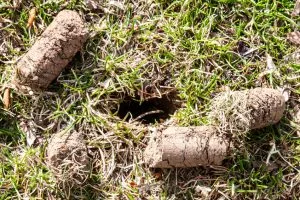When it comes to basic lawn maintenance, people tend to think that mowing, watering, and fertilizing are the only items on the agenda. But tackling these basics may not be enough to achieve the beautiful, lush results you desire. Read on to learn about the benefits of aerating your lawn.
What Is Aeration?
We all see it from time to time – a neighbor’s yard covered with small holes. Have you ever wondered how these holes came to be? Or maybe you know the lawn is aerated, but never knew exactly what that meant. Well, the mystery is about to be unveiled. These perforated properties have been aerated. Aeration is a process that allows water, air, and nutrients to better reach the root systems of plants and grasses. Breaking up the soil by puncturing it with a series of holes allows your lawn breathe a little, and you will reap the benefits in its appearance and health.
The Benefits of Aerating a Lawn
Simply put, aerating promotes grass growth. When grass grows in compacted soil, roots don’t receive enough nutrients, water, or air. Lawns can also have too much thatch. Thatch is an accumulation of dead grass and debris just above the soil. A thin layer of it is beneficial, but if the layer is more than 1/2 inch, it blocks out sunlight, air, water, and nutrients as well. Aeration breaks up thatch and compact soil, and therefore, helps your lawn in the following ways:
- Improves the soil’s intake of nutrients.
- Allows more oxygen to reach the roots.
- Enhances water absorption.
- Minimizes water runoff issues and puddling.
- Reduces maintenance requirements.
- Helps reduce stress from drought and heat.
- Strengthens root systems.
Does Your Lawn Need Aerating?
The aeration process is an efficient way to improve your soil’s health. A lawn that experiences heavy foot traffic, frequent romps from pets, and daily playtime with kids is in need of this process more often than one that is just for show. Aerate a well-traveled lawn at least once or twice a year, even if it is just in the areas that need it most. Healthy lawns can benefit from an annual aeration as well.
The How and When of Aerating
Aeration, also known as core aeration, soil cultivation, coring, or spiking, uses special equipment with tines to create holes in the soil. The tines can be solid (spike aerators) or hollow (plug aerators). The hollow ones tend to have better results, because they actually pull out a plug of soil. The holes should be up to four inches deep and and two-to-three inches apart.
After aeration, the lawn is perforated with holes and may have small soil plugs scattered about. These plugs eventually disintegrate and blend back into the lawn. In a week or two, you should notice an improvement in the turf’s health.
Aerate cool season turf grasses like Kentucky bluegrass and ryegrass in the spring or fall. Aerate warm season grasses like zoysia and Bermuda from the middle of spring through summer. It’s best to apply fertilizer afterwards.
To find out more about the benefits of aeration and the proper techniques for your yard, call a trained expert today. Contact Free Spray Lawn Care at 419-529-5296 and let us help you discover a lush, healthy lawn.



Comments (0)
Thanks for your comment!
Thanks for your feedback! Your comments have been successfully submitted! Please note, all comments require admin approval prior to display.
Error submitting comment!
There is a problem with your comment, please see below and try again.